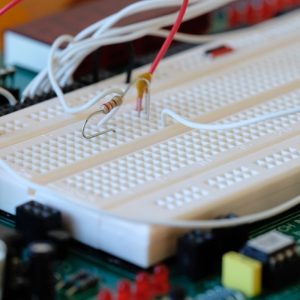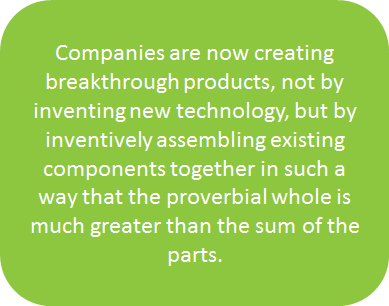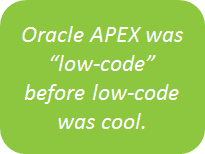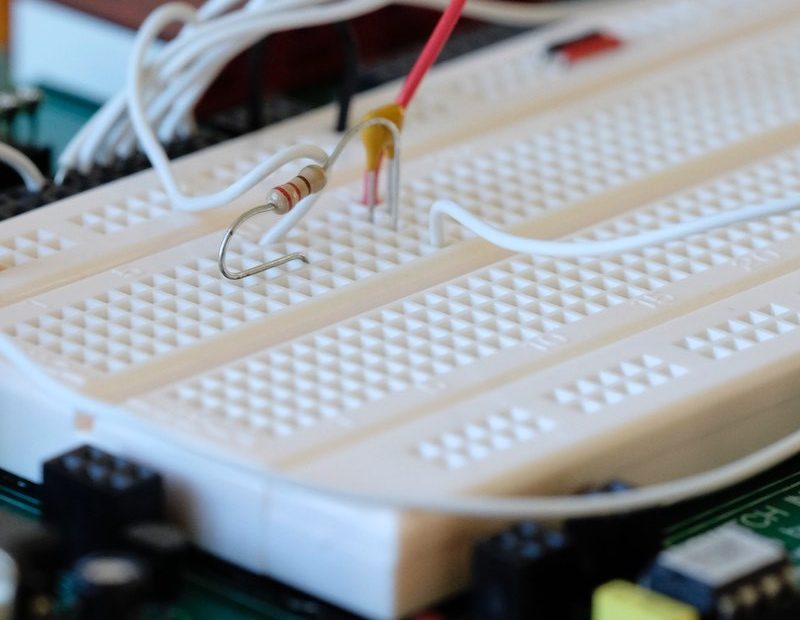The first time I ever built an electronic circuit was at a hands-on session led by Anton Nielsen at Kscope15. We built a nifty little heat sensor that interacted with a cloud-hosted Oracle APEX app to display temperatures, all within an hour or so. In addition to Anton’s superb instruction and guidance, what enabled absolute beginners like me to complete the project so quickly was that Anton provided us with breadboards to use a conduction base.
 What’s a Breadboard?
What’s a Breadboard?
A breadboard is a basically a plastic block with rows of pre-wired holes where you can plug in wires and components to build electronic circuits. There’s an electrical connection between the holes. When you plug things in, they automatically become connected electrically as well. However, unlike the early breadboards of the past, (which were literally wooden boards used for cutting bread(hence the name), modern breadboards are solderless.
When prototyping or building an electronic circuit, it’s very useful to have a way to quickly connect components together, and perhaps more importantly, to be able to swap them out or change their place if necessary. For this reason, breadboards are a big timesaver, especially for beginners:
[A] Breadboard is a great way to construct electronic projects easily and in less time without the need of soldering. A problem that is faced by beginners in the field of electronics is that they cannot solder the components neatly on printed circuit boards. One bad solder joint can lead to the project not working. […] Another problem faced by them is that if they try to solder and make a project, it does not work because of poor soldering or the circuit that was taken from a book or magazine lacked instructions or it was wrong. Now after spending a lot of time on making it, what they have to face is disappointment. (Source: ”10 Breadboard Projects for Beginners” on Instructables)
APEX as a Breadboard
Even if you haven’t had your morning coffee, I’m sure you can guess where I’m going with this…
Simply swap out a few words in the above Instructables quote and you’ll see why a low-code development framework like Oracle APEX is very much like a breadboard, where you can quickly connect components together without “soldering”:
“APEX is a great way to construct applications easily and in less time without the need of coding. A problem that is faced by beginners in the field of application development is that they cannot code the components…”
Of course, with all its built-in functionality, APEX does much more for application development than breadboards do for building electronic circuits. But the principle is the same. By taking care of all the low-level, trickier parts of web-based application development (think authorization, authentication, session state management, styling, templating, database connections, etc.), APEX helps beginners get applications up and running more quickly, and also helps experienced developers go faster than they could otherwise.
 Although easy to overlook, tools that make it easier for people connect things together more easily are deceptively powerful. To see what I mean, consider a major trend we are seeing with technology innovation today. Companies are now creating breakthrough products, not by inventing new technology, but by inventively assembling existing components together in such a way that the proverbial whole is much greater than the sum of the parts.
Although easy to overlook, tools that make it easier for people connect things together more easily are deceptively powerful. To see what I mean, consider a major trend we are seeing with technology innovation today. Companies are now creating breakthrough products, not by inventing new technology, but by inventively assembling existing components together in such a way that the proverbial whole is much greater than the sum of the parts.
Let me share an example.
Lego-style Innovation
February 14, 2017 marked a world record for the most satellites ever launched on a single rocket. A total of 88 satellites entered low earth orbit aboard one PSLV rocket fired from a space center in India. A second world record followed when the 88 satellites joined those from earlier launches. Together they created the largest ever private satellite constellation totaling 149. Equally impressive is what these satellites will do: Once fully commissioned, they will image the entire earth every single day!
But do you know what the most remarkable thing is about this story?
Rather than being the feat of a well-funded nation-state, it was the accomplishment of a relatively new company called Planet Labs, whose stated “aerospace know-how meets Silicon Valley ingenuity” approach enables it to design, build and launch satellites faster than any company or government in history.
Off the Shelf Components
The approach? Planet assembles the satellites using readily available, off-the-shelf components, such as common laptop batteries and smartphone chips. The resulting satellites are only slightly larger than a shoebox. Just as importantly, they cost a fraction of the many millions it usually takes to build satellites with similar capabilities.

Think about that for a minute. Only well-heeled governments could even consider such a project. All it took was a scrappy, 40-person startup using commodity consumer electronics.
And it’s not just Planet Labs doing this type of innovation. Many organizations are. Universities, robotics companies, and the US military, all are building ingenious products by cleverly assembling components built by others. According to Geoff Colvin of Fortune magazine, “we’ve entered the era of Lego innovation, when highly valuable and significant advances in technology are achieved by imaginatively combining components and software available to everyone.”
Oracle APEX – Imaginatively Combining Components
This, of course, brings us right back to breadboards and low-code application development platforms like Oracle APEX – tools purposely built for “imaginatively combining components” to build solutions.
 See, Oracle APEX was a low-code tool before low-code was cool. For several years now, even those with little to no coding experience could use APEX to build highly functional and professional looking applications. They could do this by“imaginatively combining” the UI components included with the product. These components include charts, interactive grids and reports, calendar controls, shuttle controls, date pickers, color pickers, and on and on.
See, Oracle APEX was a low-code tool before low-code was cool. For several years now, even those with little to no coding experience could use APEX to build highly functional and professional looking applications. They could do this by“imaginatively combining” the UI components included with the product. These components include charts, interactive grids and reports, calendar controls, shuttle controls, date pickers, color pickers, and on and on.
APEX is Highly Extendable
However, what really makes APEX a great “breadboard” is its alignment with industry trends and standards. This is what makes it highly extendable. With strong support for HTML5, CSS3 and JavaScript library integration, a whole world of readily available 3rd party components can be embedded within an APEX application, enabling developers to create highly functional applications that provide a great user experience:
- Need a Google Earth like virtual globe to dynamically visualize geospatial data? Check out Cesium.
- Need Visio like “drag and drop” functionality to build a visual workflow editor? Check out Draw2D.
- Want to sync browser sessions (i.e. desktop and mobile) without forcing users to log in? Leverage Firebase. (See the related KScope17 calendar app here.)
- Mobile maps? See Leaflet.
- Want to seamlessly pull in user entered data from a Google sheet with the click of a button? Leverage the Google Sheets API.
- Need great looking charts? Check out D3.js (which integrates with APEX straight out of the box).
- Want to use Material Design for your APEX app? Take a look at Vincent Morneau’s Material APEX.
- Need a super dynamic and rich user interface? Check out KnockoutJS, which Jorge Rimblas used to create an amazing app for timesheet entry.
The possibilities are endless.
At Insum, we are fortunate to have a wide range of clients with many different needs. This means we regularly have the opportunity to integrate different components into APEX applications, including all those listed above. One of the most interesting challenges will always be discovering what types of components and libraries are available, and how they can be combined into solutions to solve real-world business problems. Get your breadboads out.


Hi, green remarks are difficult to read,